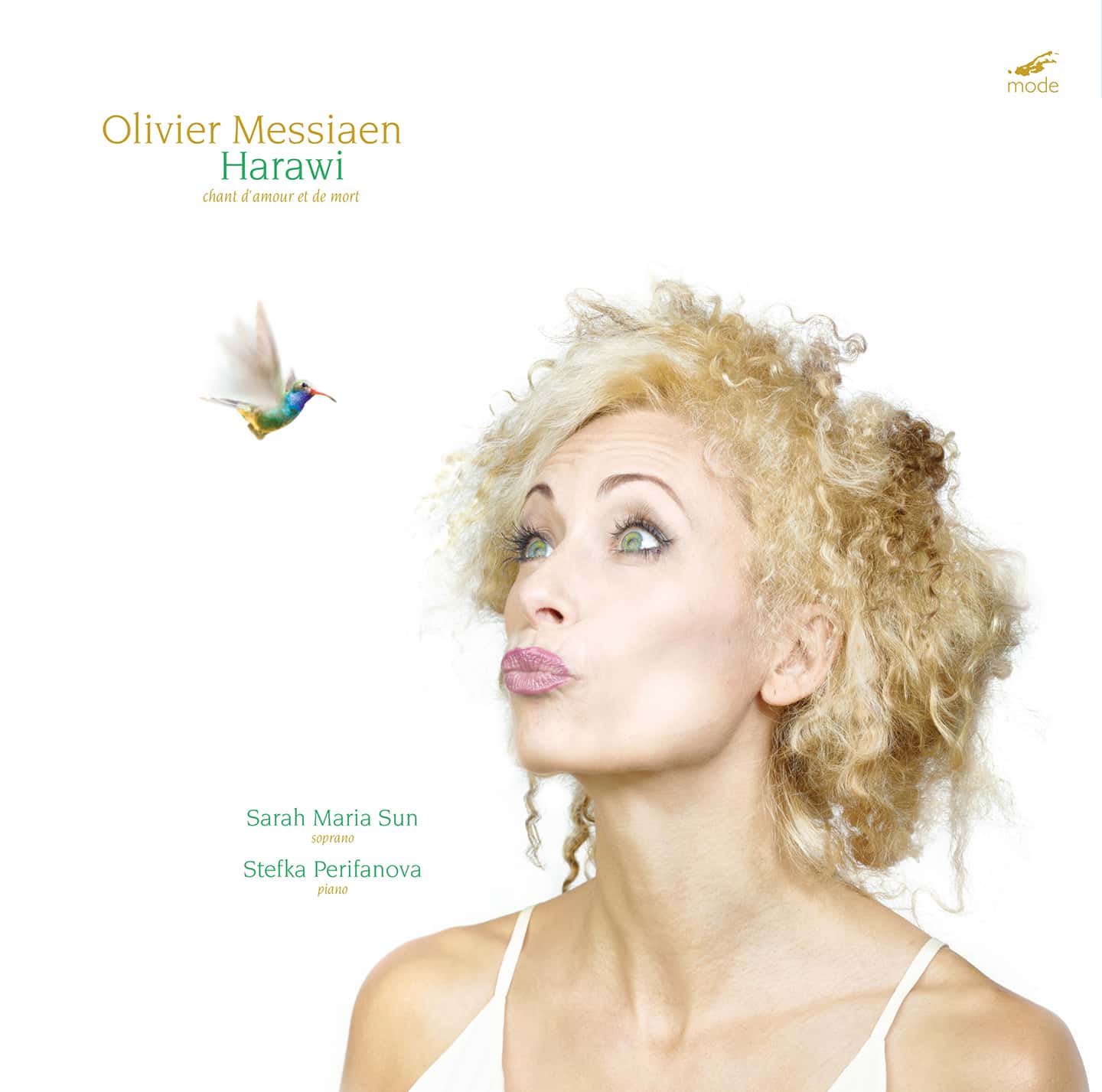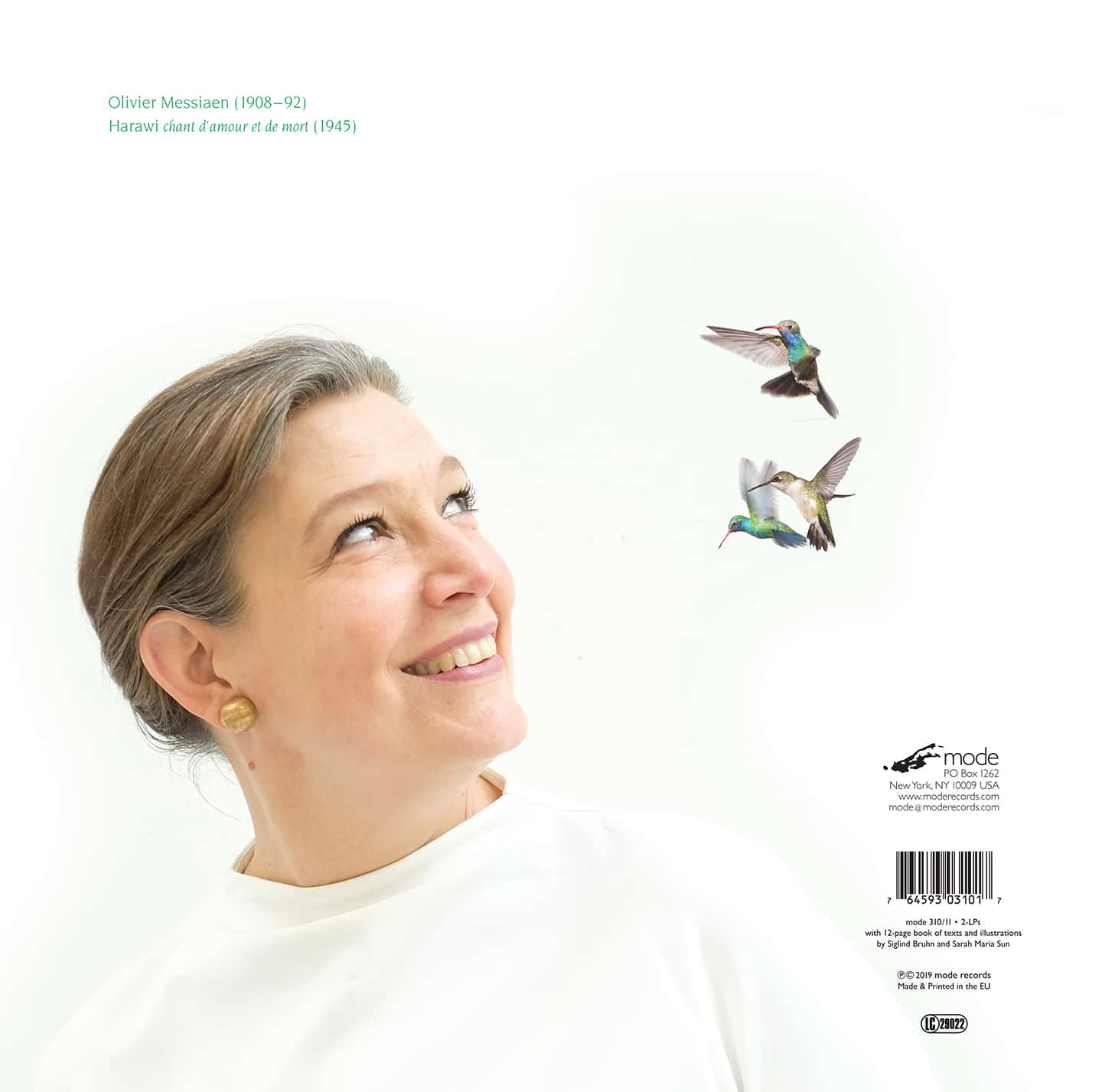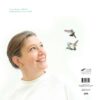Harawi
Sarah Maria Sun, soprano
Stefka Perifanova, piano
mode 310/11 (2-LPs)
2-LP set $37.49 (plus shipping) or CD-quality
download from Mode $24
Harawi is a cycle of twelve songs scored for soprano and piano composed in 1945. Harawi (known to Spanish speakers as yaraví) designates a song about a fated love that ends in the death of both lovers. Messiaen remarked that “it is the story of Tristan and Isolde.”
The surrealistic text of Harawi is Messiaen’s own. Using the musical structures Messiaen had created for Harawi, he built massive phrases in these songs, expanding space and time, creating extreme tenderness, vastness, clarity and abysses.
In Harawi both lovers are not only human, but beings, which transform again and again. Destruction, pain, death, creation, joy, dance and love are not final — they are all ever changing particles of our interwoven cosmic existence.
• Deluxe, specially priced 2-LP set with gatefold cover
• Includes 12-page book with complete lyrics plus extensive text on Harawi by Siglind Bruhn, including copious illustrations and musical examples
• Complete song texts included
• Pressed by Pallas in Germany
• NOTE: there is no CD format release, only the 2-LP set and digital
• The only recording of Harawi currently available on LP
Liner notes by Siglind Bruhn and Sarah Maria Sun.
Reviews
Already chosen as ONE OF THE BEST RELEASES OF 2019 (from a pre-release review copy) by Lynn René Bayley of Art Music Lounge!
“This stunning album … features the still-young and somewhat outré German soprano Sarah Maria Sun… From the first notes of La ville qui dormait to the dying piano sound in Dans le noir, this is a performance that will absolutely rivet you… This clearly goes straight to the top of performances of this unusual and somewhat difficult song cycle…”
This stunning album, scheduled for release on September 20 of this year, features the still-young and somewhat outré German soprano Sarah Maria Sun in a performance of Olivier Messiaen’s Harawi, and as good as I thought Tony Arnold was in her New Focus recording of this song cycle—and she was, indeed, very fine—Sun is positively transcendent.
From the first notes of La ville qui dormait to the dying piano sound in Dans le noir, this is a performance that will absolutely rivet you. Sun achieves this miracle as much, if not more, by the sheer quality of her voice, though she interprets very well. Although Arnold may score a few points in interpretation over her here and there, she doesn’t cast as much of a spell over you with the sheer sound of her voice, and Arnold does have a very attractive voice. The difference is like listening to a good coloratura soprano—let’s say Natalie Dessay in her prime—and then listening to someone with the ethereal voice of a Kathleen Battle. No matter how good Dessay was, Battle is going to score over her just because the voice itself is exceptional and has overtones in it that Dessay’s does not. The same comparison holds regarding Sun vs. Arnold (or anyone else, for that matter).
But don’t think for a moment that Sun does not grasp these elusive songs. She does a remarkable job with the lyrics in many of them. It’s just that the overall ambience of the voice is hypnotic in and of itself. And pianist Stefka Perifanova, a name new to me, captures fully Messiaen’s slightly wacky transformation of bird calls into piano notes. Where Sun seduces and cajoles the listener, Perifanova provides an offsetting joyous energy. They complement each other in a way that only the best singer-accompanist duos can.
Normally, I don’t care for CD sonics with much ambience or reverb in them, but the way this disc is engineered actually complements not only Sun’s voice but the specific vocal effects she creates. In fact, I would credit the CD sound as the third “performer” in this cycle. With drier or tighter-miked sound, some of the magic would disappear. Does this mean that Sun couldn’t duplicate this kind of magic in a live concert? Not necessarily. All she’d have to do is select a hall with good ambience, place herself several feet back from the first row of the audience, and let her voice fly up to the rafters. I saw and heard Kathleen Battle do the same thing, way back in 1978, in Cincinnati’s Music Hall, a recital with James Levine at the piano. Know how to use your space, and the space will benefit your voice.
This clearly goes straight to the top of performances of this unusual and somewhat difficult song cycle. A must-have for those who enjoy this cycle.
—© 2019 Lynn René Bayley
https://artmusiclounge.wordpress.com/2019/08/15/sarah-maria-suns-hypnotic-harawi/
“One of the exciting characteristics of this recording is the strong bond that the two musicians reveal. … What makes this recording so unique that if you listen to it for a long time you even get the impression that Sarah Maria Sun and Stefka Perifanova are filling Messiaen’s work with their own stories and are thus continuing to paint the original painting.”
Demnächst legen die Sopranistin Sarah Maria Sun und die Pianistin Stefka Perifanova eine neue Aufnahme des Liedzyklus “Harawi” von Olivier Messiaen vor. Brauchen wir davon wirklich noch eine Aufnahme? Sie haben recht, wir brauchen sie! Vor allem wenn zwei so versierte Musikerinnen ihre ganz eigenen Maßstäbe und Perspektiven anlegen. Denn für beide ist dieses Werk ein ideales Spielfeld um Fähigkeiten zu zeigen, Persönlichkeit auszuleben, und auch Weiterentwicklungen zu durchlaufen.
Liebe & Tod
Messiaen schrieb “Harawi” im Jahr 1945 als ersten Teil seiner Tristan Trilogie. Das Wort „Harawi“ kommt aus der andischen Musik Südamerikas, und beschreibt ein Genre von Liebesliedern die oft mit dem Tod der Liebenden enden. Die Texte der Lieder bestehen aus surrealer Fantasiesprache , die höchstens in Symbolen zu verstehen ist. Ein Zusammenhang zu der in der Zeit vor der Komposition aufgetretenen psychischen Erkrankung Messiaens erster Ehefrau Claire Delbos ist zwar nicht durch eine Widmung des Werkes belegt, jedoch auch nicht auszuschliessen.
Gestaltung und Ausführung
Eine der begeisternden Eigenschaften dieser Einspielung ist die starke Verbundenheit, die die beiden Musikerinnen offenbaren. Jede kann ihren Weg gehen, ihre Ziele verfolgen, und doch mit der Duopartnerin Hand in Hand bleiben.
In “L’amour de Piroutcha” singt Sun sehr frei, setzt die hohen Töne langsam und mit Bedacht an, und gibt der Musik so viel Atmosphäre. Dabei löst sie sich von traditionellen Techniken in Bezug auf Vibrato und Tongestaltung, und befreit somit die Musik zur Weiterentwicklung. Währenddessen nimmt Perifanova jede Gelegenheit gerne wahr um Widersprüche zu betonen, spielt nicht so sehr gefällig, sondern stellt stattdessen Fragen in den Raum.
Und dabei spielen beide Musikerinnen mit diesem blinden Vertrauen, finden auf den Punkt wieder zusammen.
Die Vielfalt in der Vortragsgestaltung zeigt sich auch in “Répétition planétaire”. Hier spielt die Pianistin plötzlich mit forderndem Tempo und gibt so dem Vortrag einen treibenden Charakter. Sun geht diese Intensitäten gerne mit und baut sie für sich weiter aus, indem sie geschickt ihr Timbre variiert um in Steigerungen noch mehr Spannung zu erzeugen.
Charakterstark
Insgesamt hat Sarah Maria Sun so eine große Formantbandbreite, die sie erfreulicherweise in dieser Aufnahme konsequent nutzt. Wo andere Sopranistinnen im Grundklang ihrer Stimme eingeschränkter sind, und hörbar daran arbeiten müssen, aus Selbigem auszubrechen, sitzt Sun sozusagen mittendrin in einem weiten Klangestaltungsfeld. So kann sie ganz ohne Mühe von dunklen, warmen oder sogar muffigen Klängen, zu helleren, manchmal bis zu scharfen, von immer geschmackvoll gesetztem Vibrato gestützten Tönen wechseln. Diese Anlage zusammen mit ihrer Ausbildung geben ihr Gestaltungsmöglichkeiten, die viele andere nicht haben. Die beeindruckenden Melodiekaskaden in “Adieu” sind nur ein Beispiel dafür, dass Sun diese Möglichkeiten eindrucksvoll zu nutzen weiß, während die Pianistin immer in ihrer Nähe spielt, und auch immer wieder zu ihr zurück findet. So gestalten sie Passagen manchmal einmütig, um anschliessend Perifanova die komplexeren Akkordgerüste mit transientenreichen Stakkati in den Raum werfen zu lassen.
Was Eigenes
Diese natürliche Gestaltungsfreude beider Musikerinnen findet immer wieder Höhepunkte, zum Beispiel wenn Sun die vielen Repetitionen in “Syllabus” gern als Gelegenheit nimmt zu formen, Strukturen zu bilden, sogar ein bisschen Katz und Maus zu spielen mit Perifanova. Oder wenn die Sopranistin und die Pianistin die jazzähnlichen Harmoniken in “Escalier” mit jovialer Spielfreude genießen.
Viele dieser Gestaltungsereignisse finden so in anderen Aufnahmen von “Harawi” nicht statt. Das macht diese Einspielung so einzigartig, dass man bei längerem hören sogar den Eindruck gewinnt, Sarah Maria Sun und Stefka Perifanova füllten Messiaens Werk an mit eigenen Geschichten und würden so das ursprüngliche Gemälde noch weiter malen.
Zum Glück müssen wir auf dieses spannende Erlebnis nicht mehr lange Warten. Die Veröffentlichung wird Ende September vorliegen auf Vinyl und bei Amazon / iTunes (Mode Records, USA).
— Stefan Pillhofer, orchestergraben.com, 3 September 2019
https://orchestergraben.com/album-preview-harawi-mit-sarah-maria-sun/




